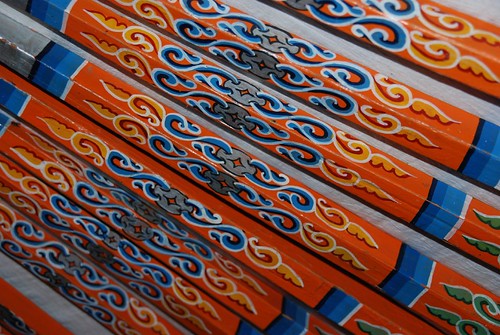Motivated by both Melanies (yep, one from Germany and the other one living in Guadeloupe) we decided that it was maybe time to revive this picture in the picture category again. After all it is nice even for us to travel with help from our pics and we do realize that we really have a story to tell for each of them.
Today we want to talk a little bit about yurts. During our time in Mongolia we decided to go on a tour to see the country. Mongolia is vast, there is only one official road connecting the current capital, Ulan Bator with the old capital, Karakorum. All the rest of the roads are “dust tracks” that are impossible to get along on, except if you have a sturdy old Russian jeep and a driver who for some reason knows that if he meets this one particular bush that is opposite this one mountain and with the sun setting over this one sandhill, that he has to make a 90 degrees turn to the right. In other words: it’s impossible to know where to go as everything resembles; all the bushes look the same, as do the mountains and the sandhills, but those drivers “just feel” where to go and during our 12-day trip we never got lost and always found some yurts to sleep (although, to make it even more difficult, Mongolian people are nomads, so those yurts move all the time too).
In Mongolia, yurts are actually called gher and most families own 2 of them: one for the family to live in and another one for guests. As mentioned before, ghers are designed to be dismantled quickly in different parts so that nomads can transport them easily while their flock moves on in the search of rich grassland. Traditional ghers, like in Mongolia, consist of a circular wooden frame carrying a felt cover, which is made from the wool of the flocks of sheep the family owns. The timber of which the external structure is made, must be obtained by trading in the small settlements as wood is nearly impossible to find in the treeless steppes (source: Wikipedia).
The picture above shows the wooden lattice crown of a Mongolian gher seen from the inside. It’s most of the time richly decorated and the wooden lattice forms a whole through which the smoke of the heater (heated with yak dung) can escape. It’s very nice to lie in the gher, on a wooden bench covered with a blanket (yep, that’s the bed – stone hard really!) and look at the stars which twinkle in the pitch dark sky and think about how lucky we were to actually be here.
Vera & Jean-Christophe
PS: For those of you who would like to know more about Mongolian nomad life, we highly recommend to watch the movie “The cave of the yellow dog” a Mongolian/German film of 2005 which depicts very acurately the life of nomads nowadays.


4 Comments
Enfin des infos ! On en veut encore ! Cela nous permet de replonger dans les photos avec plaisir ! Les maisons romaines de l’antiquité avaient aussi un trou dans “le plafond” mais c’était l’Italie ! Je suppose qu’il y a un “chapeau”, en excréments de yack durcis et moulés en forme de parapluie ??? pour les jours de froid, de pluie ou de neige ?
pour les jours de froid, de pluie ou de neige ?
Oui effectivement il y avait un espèce de chapaud sur le trou (je pense que c’était plutôt aussi en peau de mouton, comme la yourte en elle-même) pour la pluie, la neige, etc. Mais bien que la nuit il faisait très froid en Mongolie quand on y était (septembre), il faisait très très chaud à l’intérieur (on était souvent en t-shirt) donc le “chapeau” on l’a rarement fermé.

En fait en y pensant je me dis qu’ils sont beaucoup plus avancés que nous les Mongoles, car nous on n’a que depuis quelques années le toit en verre de la 307 pour regarder dehors, mais eux ils ont compris ça depuis des siècles.
Vera
Tu as oublié notre vieille 205 à toit ouvrant !
@Ivana: C’est vrai.
C’est vrai.